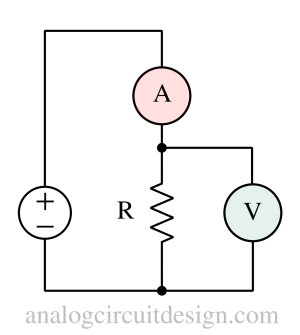Ohm's law¶
Ohm's law states that the voltage (V) across a resistor is directly proportional to the current (I) flow through the resistor.
$$V\propto{}I$$
$$\implies{}V=IR$$
The proportionality constant is called resistance (R). The resistance is the material property which can change if internal or external factors are changed e.g., Temperature. For a given applied voltage, the higher the resistance, the lesser the current. If the value of resistance is high, the material is not a good conductor.
Measurement setup for Ohm's law¶

The current is measured through a resistor, so the ammeter is connected in series. The resistance offered by an ammeter is zero (short circuit). That is why there won't be any voltage drop across the ammeter. So, the voltage offered by the source will directly come across the resistor.
The voltage is measured across the resistor, so the voltmeter is connected in parallel with the resistor. The resistance of the voltmeter is infinite (open circuit), so it won't draw current and won't cause errors in measuring the current through the ammeter.
Short circuit¶
A short circuit is the circuit condition when the resistance is approaching zero. This means that for a non-zero voltage, the current through that resistance is approaching infinite.
Open circuit¶
An open circuit is a circuit condition when the resistance is approaching infinite. This means that even for a very high voltage, the current through that resistance is approaching zero.